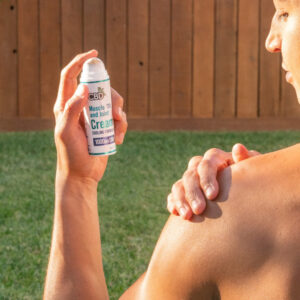After a particularly strenuous workout, you’re probably all too familiar with the typical ice-pack-aspirin-foam-roller trifecta. It’s not a sign of weakness if your muscles and joints hurt after a long outdoor run or an afternoon at the gym. It’s really a perfectly natural indicator that you’re growing stronger. But just because something is normal doesn’t mean it’s pleasant.
As a result, an increasing number of athletes are turning to topical CBD products as a more natural and effective solution to relieve some of their post-workout muscular soreness.
-
Heals post-workout recovery
During sportspersons’ strenuous workouts, muscle fibers might be microscopically injured. These muscles become inflamed, causing the body to respond by attempting to repair the damage, resulting in stiffness and muscle discomfort.

The best hemp cream has been shown to have more antioxidant activity than other powerful antioxidants like vitamin C and E, making it a feasible alternative for treating post-workout inflammation.
CBD can reduce inflammation and enhance mobility and discomfort in people with multiple sclerosis, according to a 2018 study.
-
CBD is not a narcotic.
It’s a popular misperception that CBD, like alcohol or opioids, acts as a narcotic, numbing the pain sensation. However, nothing could be further from the truth.
While members of the marijuana family contain psychoactive recreational THC, the PCR hemp plant, which is grown in the United States, provides CBD that can be easily purified to a THC content of 0.3 percent or below. That level is too low for standard drug testing to detect.
-
CBD sings in unison with the human body.
CBD works by recharging the body’s natural endocannabinoid system, which is found in all of the body’s major tissues and organs. Parts of the endocannabinoid system might become out of balance during times of stress and pressure. Exogenous CBD can help to restore system equilibrium, which can have a good impact on mood, anti-inflammatory responses, and pain management.
-
Naturally, it’s comparable to over-the-counter medications.
Aside from the fact that they don’t function, OTC pain medications like Advil and Aspirin are synthetic compounds that can put a burden on the liver. Such stress on the liver might exacerbate the body’s ability to mend, leading to more issues and pharmaceutical use. CBD, in turn, has been shown to be more effective than over-the-counter drugs without causing liver damage.
-
Energy restoration
Many sportsmen have previously relied on energy drinks, tablets, or caffeine to increase alertness and energy. Caffeine is the major element in energy drinks and pills, and when consumed in excess, it can cause side effects such as rapid heartbeat, anxiety, and tremors, as well as withdrawal symptoms. CBD has no adverse effects or withdrawal symptoms, which makes it ideal for energy restoration.

-
Heals broken bones
One of the most common sports-related injuries is a broken bone. The body begins the mending process after a broken bone by forming callus at the fracture site, which bridges and plugs the gap between the split ends. CBD helps fracture repair by boosting the protein collagen found in the bones, according to research.
-
Treats traumas
Concussions or other types of brain injuries can occur in contact sports like soccer, boxing, baseball, hockey, or ice hockey, affecting brain function. CTE (chronic traumatic encephalopathy) is a degenerative brain disease that affects athletes and anyone who has had repeated head trauma. In a 2017 study published in The Journal of the American Medical Association, CTE was found in 110 of 111 deceased NFL players.
-
Rotator cuff injuries
The rotator cuff is responsible for maintaining the stability of the shoulder blade. The rotator cuff is prone to injury and inflammation in sports that require repeated use of the shoulder, such as tennis, baseball, or swimming. Apart from swelling, the most typical symptom is a pain when trying to elevate the arm or reach behind the back.
-
Runner’s knee
Runner’s knee is a repetitive-motion injury that is frequent among marathon runners and other sports that require biking and running. The discomfort is felt immediately below the kneecap, and the area swells.
-
Strains
Strains differ from sprains in that a strain includes injury to the muscle, whereas a sprain affects the ligament. When muscular tissue is overstretched or overextended, a strain can occur. Strains are common in sports when a person is lifting, running, jumping, or changing directions quickly.
Checklist for CBD Cream Quality:
- Is the CBD Dosage stated on the label? Non-disclosure isn’t always a good idea.
- Is the CBD derived from organic hemp? Pesticide-free CBD comes from hemp produced organically in the United States.
- What method was used to extract CBD? Rather than items created by chemical separation, you’ll prefer a cream containing clean CO2 extracted CBD.

- Are there any synthetic dyes in the mix? Artificial additives have the potential to irritate the skin.
- What is the base of the lotion, and would all of the aid of the chemical with pain? CBD is only a small part of a powerful cream. Ascertain that the lotion as a whole promotes relaxation.
- Was the cream or lotion evaluated for purity by a third party? Assure that all 3rd party testing is easily available immediately on the product page and is up to date to ensure product safety and consistency.
- What is the policy on returns? Brands of high quality stand behind their products and have generous return policies.
What Are The Differences Between Topical Lotions And Creams And Ingested Oils And Confections?
CBD is delivered to the source using topical lotions and creams. That implies you can get pain relief and comfort with less CBD. It also means that CBD’s effects will be limited to the area where it is applied. In contrast to ingested CBD, which interacts with the entire body’s cannabinoid balance.
How Do I Read The Label For Cbd Dosages And Concentrations?
When buying CBD products, figuring out the dosage per serving can be more difficult than usual. The most important thing to remember is that the total CBD content is usually listed on the label of CBD products.
If you’re buying a tincture that states 750 mg CBD on the top, for example… This indicates that the entire container contains 750 milligrams. If you buy a 100 mL bottle, you’ll get 7.5 milligrams of CBD for each 1 mL dropper.
